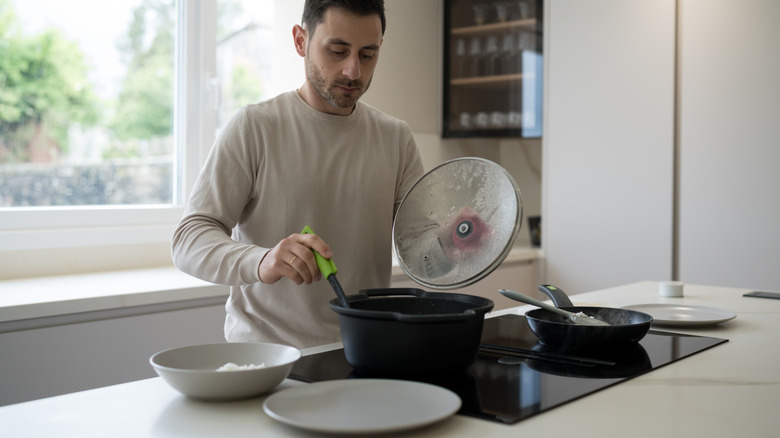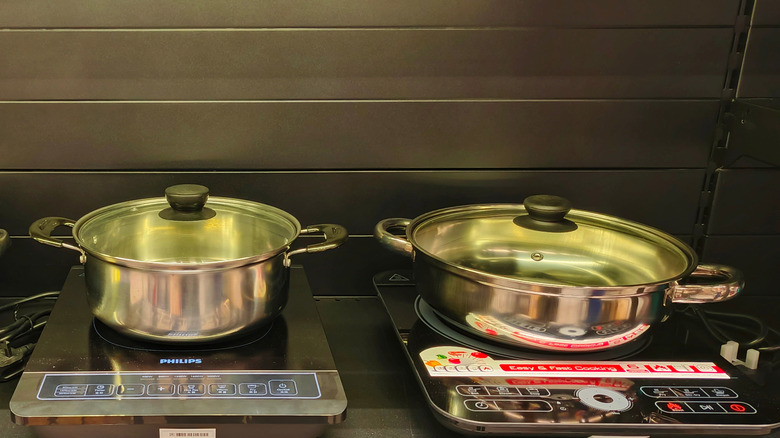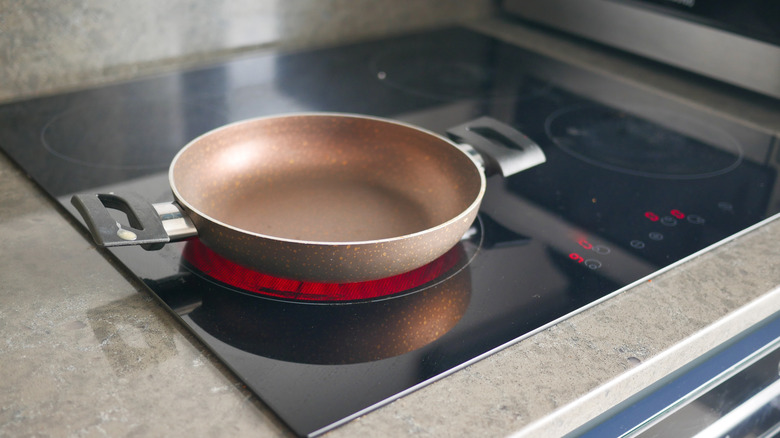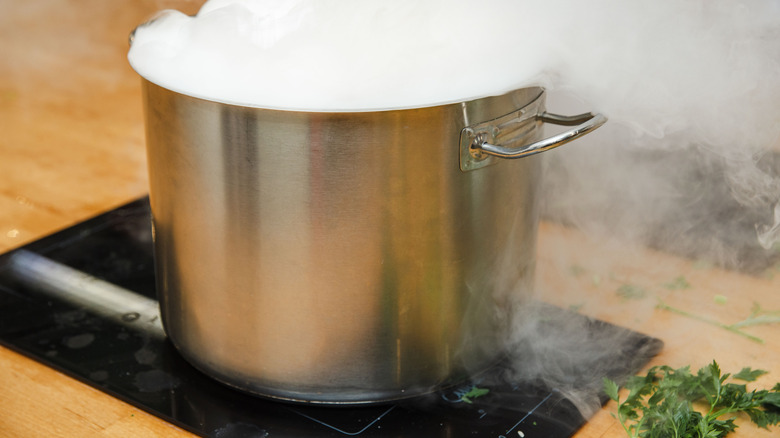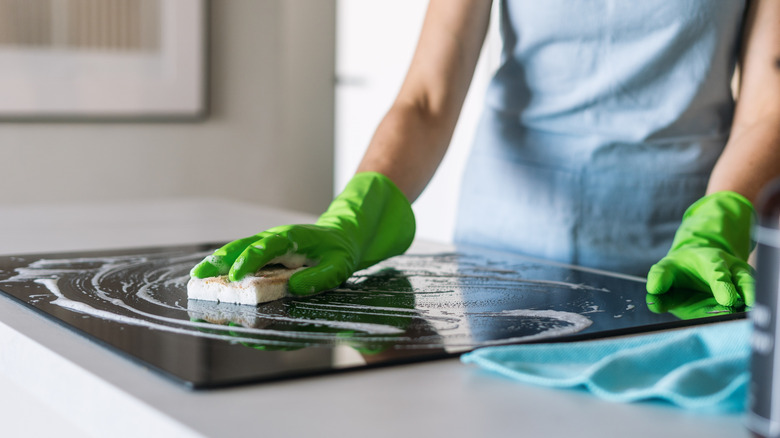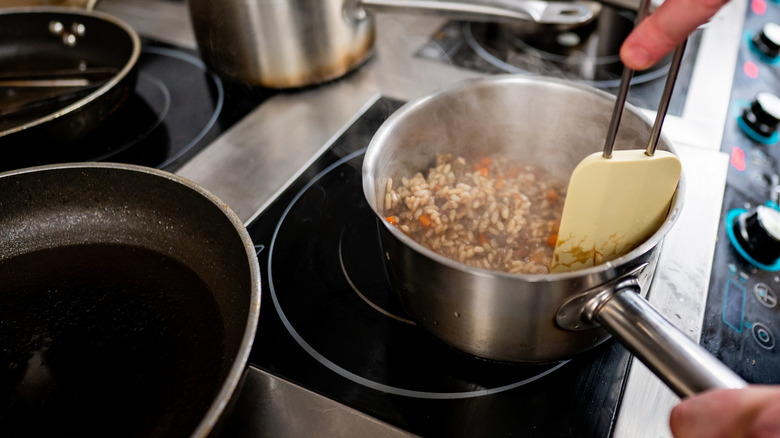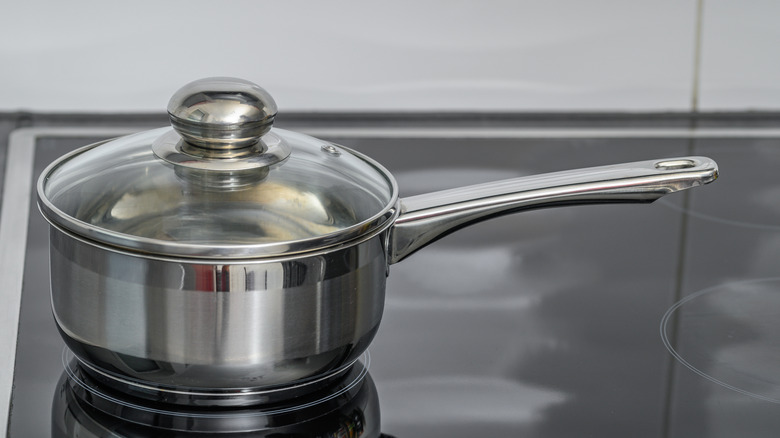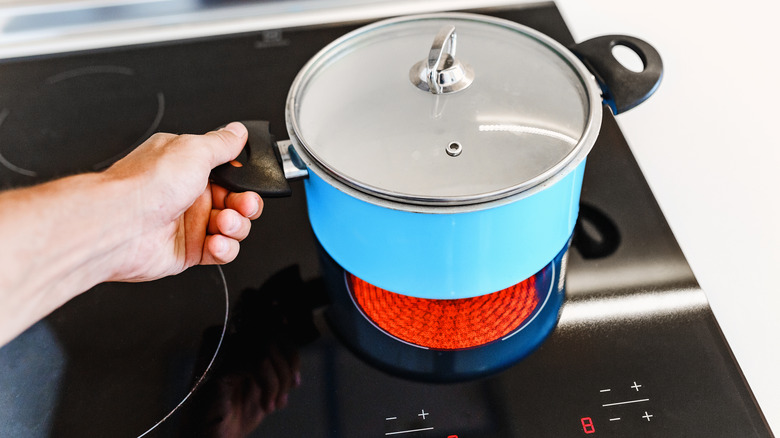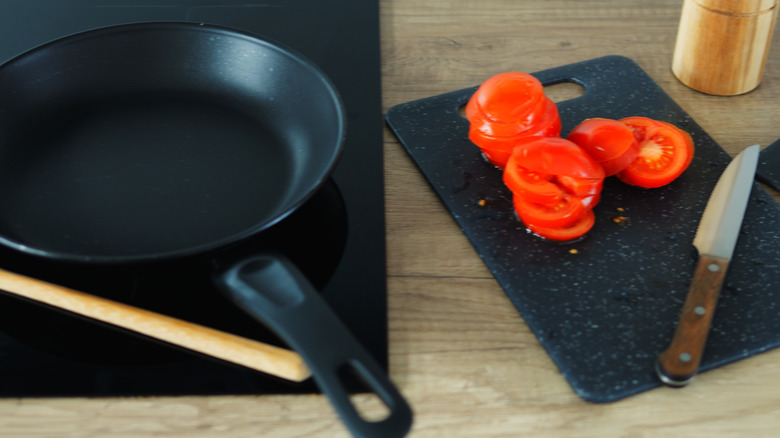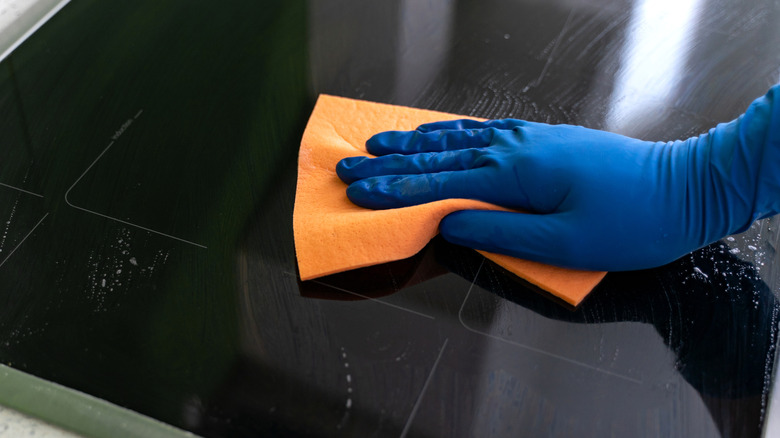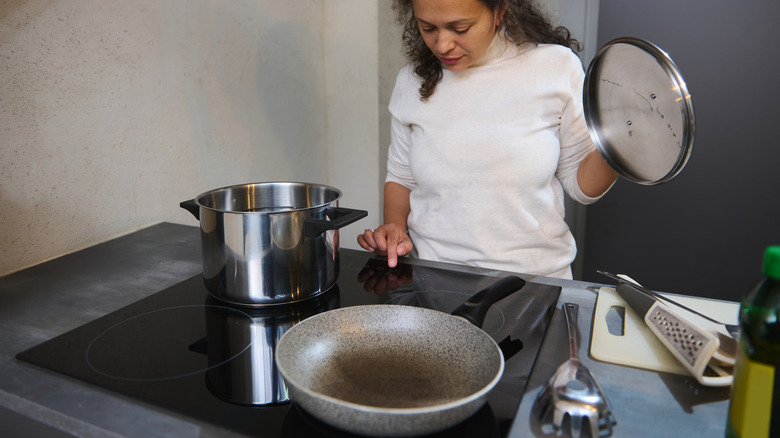12 Things You're Probably Doing Wrong On Your Induction Cooktop
The advantages of using an induction cooktop are plenty. From looking sleek and modern to cooking food efficiently, these technological marvels have made life simpler for anyone who enjoys cooking. The debate over which type of cooktop is better — gas, electric, or induction — will probably go on forever. But if you've made the switch to an induction hob, the key is to learning how to use it properly so you can take full advantage of all its many features and benefits.
Like with any new technology, there are a few pitfalls to watch out for. Small mistakes could end up ruining your meal, damaging your cookware, or even harming the appliance itself. Transitioning from gas or electric to an induction cooktop can feel tricky, mostly because of how fast things heat up. All it takes is a glance away from your pot, and you could end up with a messy cleanup or even worse, a hefty repair bill.
The good news? You don't have to learn it all the hard way. Understanding the most common mistakes people make with induction cooking will save you time and a whole lot of frustration. You might still make a few errors along the way, but forewarned is forearmed — so here's what to watch out for.
Not following the manufacturer's instructions
Let's be honest. Many of us have a natural aversion to reading instruction manuals, especially the fine print. It's tempting to just get right into using your new induction cooktop without worrying about rules and warnings. After all, it's just a few buttons — how difficult could it be to operate? And the instruction manual gets relegated to a drawer where it gathers dust (one hopes, and that it doesn't get thrown out!).
Turns out this can be quite a big mistake. Not learning the dos and don'ts of your new appliance can leave you wasting a whole lot of time and maybe even money if things take a turn for the worse and the appliance needs repairs. A manufacturer's instruction manual will contain detailed instructions about your cooktop, its operation, care, and safety features, all of which you need to familiarize yourself with. Without learning about these features, you might end up using the wrong cookware, cleaning your cooktop in a manner that can damage it, or accidentally triggering safety sensors. You may even end up damaging your cooktop and voiding the warranty, all because you thought you could wing it.
So, rule number one of induction club — Read. The. Manual. If reading isn't your thing, there are plenty of helpful YouTube videos for each and every model. These can walk you through the setup, cooking features, and safety tips. Your future self (and your cookware) will thank you.
Not using compatible cookware
One of the most common mistakes people make when using an induction cooktop is using incorrect cookware. With a gas stove, one can pretty much use any type of cookware, and everything works fine. But induction cooking is a whole different ball game. First and foremost is the size of your cookware. Using a flat-bottomed pan of the right size is essential as it can impact the functioning of your hob. If your pan does not match the size of the induction rings, it will lead to uneven heat distribution and affect your cooking.
Next is the material of your pans. Unlike electric or gas hobs that will heat any metal, induction cooktops work differently. Your cookware needs to have a magnetic base if it is to heat up properly. This is because the induction hob heats the pans with a magnetic field, not the direct transfer of heat. Use a non-magnetic pan, and it simply won't heat up. Nothing will happen, apart from you wasting your time.
The easiest way to choose the best pots and pans for your induction cooktop is to take a magnet with you to the store and check each potential pan with it. The stronger the attraction, the better the pan's compatibility with your cooktop. Materials that work best are stainless steel (with a magnetic base), cast iron, carbon steel, and enameled cast iron. Glass, copper, and aluminium, unfortunately, will not work.
Heating an empty pan
Cooking on an induction cooktop means unlearning some habits you may have picked up along the way. One of the most important ones is the old habit of heating up an empty pan before you begin to cook. While this may work on a regular hob, on an induction hob it can result in overheating that can damage either your hob or the pan and create safety hazards.
One of the main causes of damaged non-stick surfaces and warped pans is leaving an empty pan on the hob. To prevent this from happening, add a little oil to the pan and wait for it to heat up before adding your ingredients. If you'd rather avoid the oil, use a little water in your stainless steel pan instead – wait for it to evaporate, and then add your ingredients.
Because induction heats so fast, you'll probably need to adjust the way you prep and cook your food. No more chopping and dicing while you wait for your pan to heat up — instead, finish your prep first before turning on the induction hob. Otherwise, you might find your food starts to burn before you've even begun cooking. Your induction cooktop is a high-speed tool and needs to be treated with understanding and respect. Once you realize that, you are well on your way to stress-free cooking.
Overfilling pots and pans
Whether you are using an induction hob or not, miscalculating the amount your pot can hold is a common mistake. However, when you are dealing with an induction cooktop, overfilling can result in uneven heating. Overfilling your pots and pans can lead to liquids boiling over and spills, which could end up damaging the surface of your hob. Cleanups can be tedious, and the longer you leave a spill, the harder it becomes to remove, sometimes even leaving permanent stains.
In addition to overfilling your pots, avoid overloading your hob by placing too many pots and pans on it. This can lead to uneven heating, and the result? Some of your dishes may be overdone, while others may be undercooked. This happens because an overloaded hob may not be able to distribute its induction effect uniformly because of power limitations. Overcrowding can also prevent optimum airflow and circulation of heat.
In order to avoid this, try to distribute your pots and pans evenly across the cooktop, or try cooking in smaller batches. Not only will your food cook more evenly, but your cleanup will be easier, and your induction hob will thank you for the extra care.
Using harsh cleaning products
Cleaning your induction cooktop is usually a straightforward task that can easily be accomplished with a squirt of your regular detergent and a quick wipe down. But there are a few important rules to keep everything ticking along as it should. Any spills or stains need to be cleaned quickly, as they may prove more stubborn at a later time.
When cleaning your hob, be sure not to use harsh or abrasive cleaning materials. Brushes with steel bristles and steel wool are a no-no, as these will only damage the cooktop over time by leaving deep pits or scratches on it. Even applying too much pressure with a soft cloth can leave marks, so be gentle.
Since the surface is made of glass, you might think a regular glass cleaner would suffice, but think twice. Glass cleaners may contain ammonia, and this is too strong a solution to use on an induction cooktop. Using an ammonia-based solution can leave streaks on your glass top, plus it can be damaging to your health. Stick to mild dish soap, a soft sponge, or a dedicated induction cooktop cleaner for the best results.
Sliding, not lifting cookware
The glass on an induction stove is tougher than it looks and made to withstand more than just high temperatures. Usually made of heat-resistant glass, a quality induction cooktop should last for years. But like all appliances, care still needs to be taken. Induction cooktops are also prone to scratches and dents — an expected side effect of regular usage, especially if you enjoy cooking.
That said, some things can be done to prevent serious damage to the glass surface and the magnetic coils underneath. For one, avoid sliding your cookware from burner to burner or after cooking. If you do need to switch pans or move a dish halfway through the cooking process, lift it and place it gently back on the glass surface. Constant moving and dragging of cookware and risk deep scratches and ultimately affect the efficacy of the unit. If the bottom of your pans is warped or scratched, all the more care needs to be taken. Do not shake these pans or stir too vigorously to avoid damage. Wet pans or damp cooktop surfaces can also cause pans to slide unintentionally, as well as warp bases faster. Simple ways to prevent long-term damage.
If you do struggle with pans sliding over the surface, whether it's because of steam, grease, or excessive movement, invest in a silicone mat. Types specially designed for induction stoves are widely available, and not too expensive, either — a simple hack to keep things working smoothly.
Ignoring any warning signs
You know the saying, "the evidence was staring us in the face?" Most often used in detective novels or movies, it can be applied to operating your induction stovetop — or any other appliance, as well. Relatively intuitive as machines go, a good induction cooktop will tell you when things are going wrong. It's up to you to take the necessary steps to prevent the problem from escalating. For example, if you notice any unusually loud whirring fan sounds beyond what is normal for your model, weird smells, or even sparks emanating from the work surface, stop what you are doing and get help immediately. There is usually an SOS contact number of the appliance manufacturer in your manual.
Your cooktop is generally equipped to flash with the letter H to indicate that it is still hot. While induction hobs generally cool down faster than gas burners, pay heed to the flashing H sign and do not place any kitchen towels, plastic cutlery, or even an empty pan on a burner. These indicators are imperative for the smooth running as well as for your safety. Avoid placing your hands on the recently used hob top, as well.
Finally, check the environmental rating of your appliance before buying. While induction cooking is definitely more energy efficient (as compared to electric cooktops and gas stoves), it's still worth getting a cooktop with an A or A+ rating to further cut energy bills.
Leaving the hob unattended
While all good induction cooktops are built with intuitive safety systems and smart controls such as auto shut-off, cooking timers, and pan detection capabilities, nothing is foolproof. One of the most common mistakes people make when cooking with an induction cooktop is leaving the hob unattended. Whether the pan is full, nearly empty, or worse still, an empty pan, turning your back on it can lead to serious harm. An unattended pan can quickly overheat, damaging the cookware, creating overspill or burnt food, and even harming the hob's internal components – an expensive mistake that could have been easily avoided.
There are a number of real-world examples of what can go wrong. Online forums are full of cautionary tales. One Redditor shared how a tea kettle boiled dry, causing the glass top to crack. Another cautioned about leaving a stainless steel pan on high heat only to return to metallic-smelling smoke filling the kitchen. With a gas stove, visible flames make the safety hazards a lot more apparent, but remember, induction can produce high enough temperatures to warp or burn metals in no time at all. Food spills left unattended can also block ventilation channels and reduce the lifespan of your appliance.
Induction hobs do cool down quickly, and this can make one careless about switching them off. Always make it a habit to turn your hob off completely once cooking is finished to ensure safety on all fronts.
Using too high heat
Many people switch to induction cooking for its power and speed. For these very reasons, it is recommended to ease your cookware into the cooking process when using an induction cooktop to avoid warping and damage. If you are accustomed to pre-heating your saute pan or wok on high on a gas stove and then adding your ingredients, it's time to reconsider your approach. To protect your cookware and your food, always add a small layer of oil to the pan even before turning on the heat. When the oil begins to leave faint lines (much like swirling wine in a glass), you can start to cook. If you prefer not to use oil, a splash of water will suffice.
Induction cooktops spread heat evenly across the base of your pots and pans, and if you crank up the heat from the get-go, the results can be quite intense. Oil can smoke far quicker than you expect on induction compared to gas stoves, and excessive heat can ruin flavors and textures before the meal even starts coming together. Use low to medium settings to preheat your pans gradually, and only move to higher modes once ingredients are added.
Most induction hobs also feature a "boost" or "turbo" mode designed for rapid boiling. Use this feature when you need to boil water or stock, but avoid it for regular cooking. Constant use of the boost function can unnecessarily push the limits of your cooktop.
Resting non-cookware or hot dishes on the surface
Unlike clunky gas stoves, the sleek design of modern induction cooktops blends seamlessly into any kitchen. This almost makes it tempting to treat your hob as an extra counter or work space. But we are here to tell you to stop doing so. When you place utensils, chopping boards, ingredients, or hot trays on its glass surface, you are risking costly damage and safety hazards.
The copper coils fitted into an induction cooktop work by creating a magnetic field that detects cookware. If you place other foreign objects on the hob, the sensors could mistake these for pans and activate and overheat, making for serious fire risks. Magnetic utensils will heat up fast, and objects like paper towels or plastic spoons can melt, even with residual heat.
Even if switched off, the glass surface is not designed to be a work or counter space. Resting hot trays on the cooktop can trap residual heat and may lead to the glass cracking. Using the cooktop as a space for your chopping board risks scratching the surface and compromising its efficacy. The safest approach is to treat your induction cooktop as a dedicated cooking surface, and nothing more.
Not cleaning up spills immediately
One of the biggest advantages of having an induction cooktop is how easy it is to clean. Most of the time, all that is needed is a quick wipe down with a soft, damp cloth. A mild soap is about as much as it needs in case of spills. But there is a caveat: You must clean up spills as soon as you finish cooking and the surface is cool enough to touch. If you leave any food spills for too long, the residual heat can cause the stains to harden or even permanently discolor the cooktop. This is especially true for sugary spills.
Cleaning up spills immediately is not only about aesthetics. Any build-up can interfere with the proper working of the sensors and lead to uneven heating, restricted airflow around the hob, inaccurate temperature readings, and possible malfunction.
When it comes to tools, keep it gentle, though. Cleaning a glass-top stove is not the time for harsh chemicals, abrasive scrubbers, or steel wool. These will only lead to scratches and grooves on the surface, trapping food residue. Swap with gentler microfiber cloths or specific hob cleaning products, and use a light touch when cleaning up spills.
Not understanding that induction cooking is different from stovetop cooking
If you are planning to or have already switched from a traditional gas stove to an induction cooktop, you need to start from the beginning. If you have favorite recipes down to an art form and you can multi-task like a pro in a kitchen, knowing exactly when to adjust heat or add and remove ingredients — with induction cooking, all that may have to change. Because induction heats cookware directly and speedily, cook times are generally shorter. You also need to pay close attention to temperature settings and understand that any adjustments respond almost instantly. While the recipe may not need changing, it's advised to start cooking on a lower heat setting than you normally would. As the cooking progresses, you can adjust as required.
Induction heating spreads evenly across your cookware, and this eliminates any hot or cold spots, so you may not have to move the pans around or agitate the food within too much. It just takes some practice to learn the strength of various temperature values, and which ones correspond to the level of heat you need.
As compared to gas stoves, the safety features on an induction cooktop are also a bonus. You are no longer handling an open flame, and with in-built pan sensors and automatic cut-offs, many induction models are all around safer to use. It's just a matter of learning your hob's quirks and making the most of its potential.
